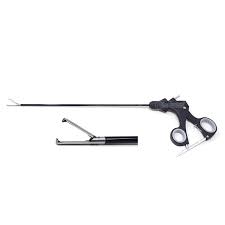Introduction
Laparoscopic needle holders are essential instruments used in minimally invasive surgical procedures for suturing and knot tying inside the abdominal cavity. These instruments allow surgeons to grasp and manipulate surgical needles with precision through small trocar ports, making them indispensable in laparoscopic suturing tasks. Their design ensures a secure grip on the needle while providing optimal control and dexterity during delicate procedures.
Design and Structure
A laparoscopic needle holder typically consists of three main parts: the handle, shaft, and tip (jaws). The handle is ergonomically designed for comfort and is often equipped with a ratchet mechanism to lock the needle in place during suturing. Some models also feature spring-loaded handles or palm-controlled grips to reduce hand fatigue and enhance control.
The shaft is long and narrow, allowing deep access into the surgical site via trocars (usually 5mm or 10mm in diameter). It is made from medical-grade stainless steel to ensure durability, corrosion resistance, and compatibility with sterilization processes. The jaws at the tip are finely serrated or cross-hatched to securely hold the needle without slippage and are designed to withstand the pressure required for consistent needle manipulation.
Types of Laparoscopic Needle Holders
Various types of needle holders are available to suit different surgical techniques and surgeon preferences:
-
Curved Jaw Needle Holders: Allow better visualization and access to angled or hard-to-reach areas.
-
Straight Jaw Needle Holders: Provide direct, controlled movement for linear suturing.
-
Self-Retaining Needle Holders: Feature a ratcheting lock system for hands-free needle holding.
-
Articulating Needle Holders: Offer flexible jaw angles to improve maneuverability in complex procedures.
Electrosurgical-compatible needle holders are also available, allowing the instrument to assist in coagulation if needed.
Surgical Applications
Laparoscopic needle holders are widely used across various laparoscopic surgeries, including:
-
Laparoscopic Hernia Repair – for mesh fixation and peritoneal closure.
-
Gastrointestinal Surgery – for bowel suturing and anastomosis.
-
Gynecological Procedures – such as hysterectomy and myomectomy.
-
Urological Surgeries – including prostatectomy and bladder repair.
Their precision and control enable safe, effective suturing in confined and visually guided environments, reducing operative time and improving surgical outcomes.
Sterilization and Maintenance
These instruments are designed for repeated use and are fully autoclavable. Proper cleaning, inspection, and maintenance are essential to ensure safe operation and long-term functionality. The jaw alignment and grip mechanism should be regularly checked for wear or misalignment. Disposable versions are also available for single-use applications to enhance sterility and convenience.
Conclusion
Laparoscopic needle holders are critical tools in minimally invasive surgery, enabling accurate and efficient suturing through small incisions. Their ergonomic design, secure grip, and versatile configurations support a wide range of surgical procedures. As a staple of any laparoscopic instrument set, needle holders play a vital role in achieving successful surgical outcomes with minimal patient trauma.






Reviews
There are no reviews yet.